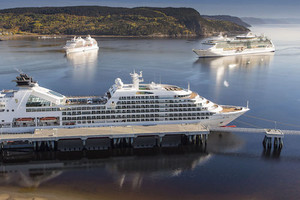
Cruising has never been more popular, with more than one million Australian cruise fans taking to the high seas each year. A growing number of people are recognising that cruising can be exceptional value for money, as well as fun for all the family. So what do new cruisers need to know? Here’s part one of our top 20 best tips to help you plan the holiday of your dreams.
Where To Cruise
Choosing where you want to cruise is the first thing to do, keeping in mind the further you travel, and the longer your cruise, the more expensive overall your holiday will be. Also, while some regions are open for cruising year round, such as our own backyard, other destinations have “seasons” such as Alaska, Antarctica or northern Europe.
How Long To Cruise
Deciding how long you want to be at sea is also important, as cruises can range from quick two-night jaunts to nowhere, to world cruises lasting over three months If you are completely new to cruising, and especially if you are not sure of the state of your sea legs, opt for a five-to-seven-day itinerary at most, as this will allow you enough time to get into the “swing of things” and enjoy both the destinations and the facilities on board, without the cruise being too long.
Choosing Your Ship
This is determined largely by your budget, and who you’re cruising with. If you like five-star cruising, but budget is a concern, the best suite on a cheaper ship is one option to consider, or the lowest grade of stateroom on a luxury ship. The main difference is that five star luxury across all elements of cruising is found on small to mid-sized ships, while larger vessels tend to have more diversity in accommodation and more facilities. It’s also important to consider who you’re cruising with, as some are built specifically with families in mind, with a lineup of kid-specific facilities, but if you’re looking for romance, it might be safer to focus on small to medium ships designed for the couples’ market.
Do Your Research
Once you have a few ships and itineraries in mind, do some more research, with things to check including the size of the vessel and the number of passengers it carries, and the number of days in port versus days at sea if you are unsure of the state of your sea-legs. Also check the availability of facilities or services which are important to you on holiday, such as a gym or alternative dining, and read some recent independent reviews to get a clear idea of the type of on board experience you can expect. And finally check on the dress code, as some ships are more traditional than others with a black tie outfit needed.
Be Accommodation Smart
Where you sleep can have an impact on seasickness if you should suffer from it, so if you get to choose a stateroom, the most stable spot is right in the middle - that’s top to bottom and side to side - and towards the waterline with a window. If you are less mobile, request accommodation near the elevators or closer to public decks to minimise walking. If budget is a concern, you can save money by booking an inside stateroom (with no window or view), and accommodation with multiple berths are good for groups of friends or small families.
Consider Any Health Concerns
Cruising has become more accessible to people of all ages, however, if you need to follow a special diet or use a wheelchair, make sure that the vessel you have chosen to cruise on can accommodate your needs. Also be mindful that smaller ships, expedition ships and river boats often do not have a doctor on board, and itineraries can involve visiting remote destinations without much in the way of medical services, or long stretches at sea, which could be a problem if there is a health emergency.
Cruising With Kids
Check the minimum age of passage with the cruise line you have in mind, or ask your travel agent to advise. Although most mass market cruise lines can accommodate small babies, there can be a minimum age to travel for providing essential equipment such as cribs. Also check that your ship has child programs and facilities, especially for younger children, and if any activities come with a price, also if babysitting or child minding services are available, and at what cost. Accommodation is also important for cruising families, as there are many options depending on the age of your kids, and the size of your budget. On large ships in particular, options can range from sharing a three or four-berth stateroom, to larger suites with two bedrooms.
Price Check
Not all fares are equal, so check exactly what you’re getting for your money. Cruise fares are quoted on a “per person” basis, not per room as land-based hotels are, and on many cruises you have to pay extra for a variety of things including soft drinks, premium coffees, alcohol, gratuities, and alternative dining. Then shop around for the best price for your cruise, as some operators may be offering benefits such as free flights, stateroom upgrades, and other incentives to lure new customers. If you’re cruising with kids, consider any cruise lines which discount child fares or allow them to cruise for free.
Research Your Destinations
Once you’ve decided on your cruise, think about what to do ashore. Shore excursions cost extra on most ships, but if you do research before you cruise, you may find that some destinations your ship visits can be easily explored on foot, or by using local transport or renting a car. Before booking anything independently, however, make sure you have enough time in port to go it alone, and only do it in places which are safe.
Make Sure You’re Insured
Even if someone tells you otherwise, you will need international travel insurance which covers a cruising holiday, even if you’re only taking a domestic cruise within Australia. Check policy details carefully, making sure everyone travelling in your party is covered adequately, and if you’re planning to engage in any sports ashore such as scuba diving, make sure you’re covered for those too. Be sure to add a copy of your policy along with any emergency numbers to your documentation.
- By:
- Joanna Hall






